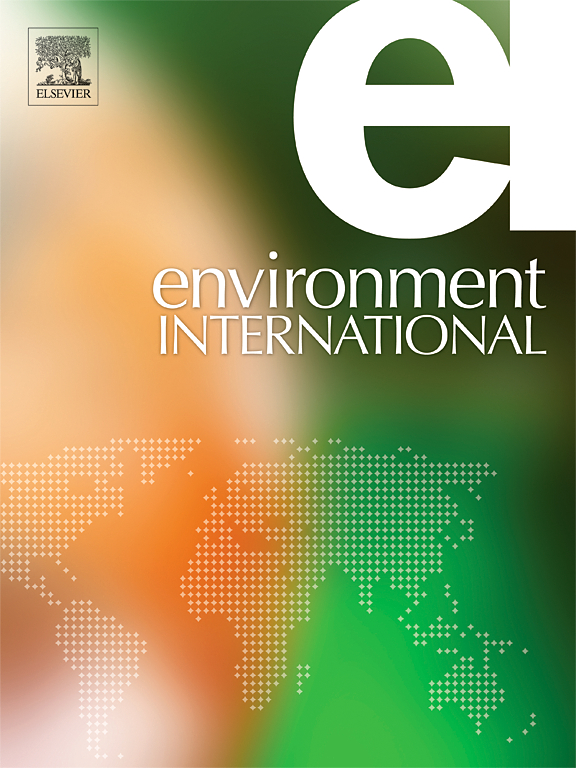Seasonal and spatial detection of pesticide residues in the ambient air of the Alsace region across different land use conditions
IF 10.3
1区 环境科学与生态学
Q1 ENVIRONMENTAL SCIENCES
引用次数: 0
Abstract
Pesticide contamination in the atmosphere is an escalating environmental and public health concern, particularly in regions with intensive agricultural activity. This study investigates the distribution of 104 semi- and non-volatile pesticides in the air of the Strasbourg metropolitan area over a two-year period, located in the Alsace region of northeastern France. Using NMC@SiC passive samplers, we assessed pesticide concentrations across six diverse sampling sites—urban, suburban, and rural. A total of 104 pesticide compounds, including 35 fungicides, 43 herbicides, and 26 insecticides, were analyzed, with detection frequencies exceeding 30 % for multiple pesticides. Notably, banned pesticides such as chlorpyrifos (61 %, 0.2–1.2 ng m-3) and lindane (18 %, 0.1–0.9 ng m-3) were still present, indicating either illegal use or long-range atmospheric transport. Average total pesticide concentrations varied spatially, with herbicide levels ranging from 3.0 to 6.6 ng m-3, fungicides from 2.0 to 5.3 ng m-3, and insecticides showing higher variability between two periods: 3.4–12.6 ng m-3 (2018–2019) and 1.9–3.4 ng m-3 (2019–2020). Urban sites consistently exhibited higher pesticide burdens compared to suburban and rural sites. Statistically significant differences were observed between urban and rural zones for fungicides (p = 0.0176) and herbicides (p < 0.05), but not for insecticides. Temporal trends revealed clear seasonality, with higher pesticide concentrations during warmer months, supported by a positive correlation with temperature (r ∼0.5, p < 0.01) and a negative correlation with rainfall (r ∼–0.5 to –0.6, p < 0.01). Principal Component Analysis (PCA) distinguishing high total pesticide events and compositional shifts between fungicide- and insecticide-dominated periods. Back-trajectory confirmed predominant westerly and southwesterly airflows, indicating atmospheric transport from upwind agricultural areas. Risk assessments revealed extremely low chronic hazard quotients (HQ < 10-3) and lifetime cancer risks (< 10-6), indicating negligible health risks via inhalation exposure for both adults and children. These findings underscore the pervasive yet low-level nature of atmospheric pesticide contamination in peri-urban agricultural regions and highlight the need for continued monitoring to capture seasonal dynamics and potential regulatory impacts.


阿尔萨斯地区不同土地利用条件下环境空气中农药残留的季节和空间检测
大气中的农药污染是一个日益严重的环境和公共卫生问题,特别是在农业活动密集的地区。本研究调查了104种半挥发性和非挥发性农药在法国东北部阿尔萨斯地区斯特拉斯堡大都会区两年期间的空气分布情况。使用NMC@SiC被动采样器,我们评估了六个不同采样点(城市、郊区和农村)的农药浓度。共分析了104种农药化合物,其中杀菌剂35种,除草剂43种,杀虫剂26种,多种农药的检测频率均超过30 %。值得注意的是,毒死蜱(61 %,0.2-1.2 ng - m-3)和林丹(18 %,0.1-0.9 ng - m-3)等被禁用的农药仍然存在,这表明要么是非法使用,要么是远距离大气输送。农药平均总浓度存在空间差异,除草剂含量在3.0 ~ 6.6 ng m-3之间,杀菌剂含量在2.0 ~ 5.3 ng m-3之间,杀虫剂含量在3.4 ~ 12.6 ng m-3(2018 ~ 2019)和1.9 ~ 3.4 ng m-3(2019 ~ 2020)两个时期之间表现出较高的变异。与郊区和农村站点相比,城市站点始终表现出更高的农药负担。杀菌剂(p = 0.0176)和除草剂(p <; 0.05)在城市和农村地区差异有统计学意义,但杀虫剂差异无统计学意义。时间趋势显示出明显的季节性,在较温暖的月份农药浓度较高,与温度呈正相关(r ~ 0.5,p <; 0.01),与降雨量负相关(r ~ -0.5 ~ -0.6,p <; 0.01)。主成分分析(PCA)区分高总农药事件和成分变化之间的杀菌剂和杀虫剂占主导地位的时期。反轨迹证实了主要的西风和西南气流,表明大气运输来自逆风农业区。风险评估显示慢性危害系数极低(HQ <;10-3)和终生癌症风险(<;10-6),表明通过吸入接触对成人和儿童的健康风险可以忽略不计。这些发现强调了城郊农业区大气农药污染普遍存在但水平较低的特点,并强调了继续监测以捕捉季节性动态和潜在监管影响的必要性。
本文章由计算机程序翻译,如有差异,请以英文原文为准。
求助全文
约1分钟内获得全文
求助全文
来源期刊

Environment International
环境科学-环境科学
CiteScore
21.90
自引率
3.40%
发文量
734
审稿时长
2.8 months
期刊介绍:
Environmental Health publishes manuscripts focusing on critical aspects of environmental and occupational medicine, including studies in toxicology and epidemiology, to illuminate the human health implications of exposure to environmental hazards. The journal adopts an open-access model and practices open peer review.
It caters to scientists and practitioners across all environmental science domains, directly or indirectly impacting human health and well-being. With a commitment to enhancing the prevention of environmentally-related health risks, Environmental Health serves as a public health journal for the community and scientists engaged in matters of public health significance concerning the environment.
 求助内容:
求助内容: 应助结果提醒方式:
应助结果提醒方式:


